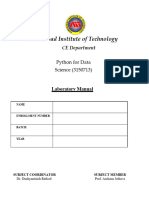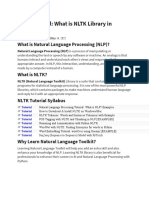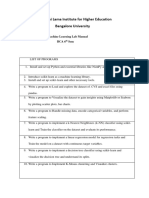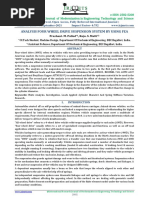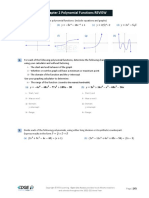0 ratings0% found this document useful (0 votes)
107 viewsAutomated Chatbot Implemented Using Natural Language Processing PDF
The document describes an automated chatbot implemented using natural language processing techniques. It discusses how the chatbot takes user questions as input, preprocesses the questions and stored answers using techniques like tokenization, lemmatization and stemming. It then calculates the similarity between the question and answers using cosine similarity and TF-IDF to assign scores and provide the highest scoring answer. The chatbot is intended to accurately answer customer questions for companies by matching user queries to stored responses.
Uploaded by
IRJMETS JOURNALCopyright
© © All Rights Reserved
Available Formats
Download as PDF, TXT or read online on Scribd
0 ratings0% found this document useful (0 votes)
107 viewsAutomated Chatbot Implemented Using Natural Language Processing PDF
The document describes an automated chatbot implemented using natural language processing techniques. It discusses how the chatbot takes user questions as input, preprocesses the questions and stored answers using techniques like tokenization, lemmatization and stemming. It then calculates the similarity between the question and answers using cosine similarity and TF-IDF to assign scores and provide the highest scoring answer. The chatbot is intended to accurately answer customer questions for companies by matching user queries to stored responses.
Uploaded by
IRJMETS JOURNALCopyright
© © All Rights Reserved
Available Formats
Download as PDF, TXT or read online on Scribd
You are on page 1/ 5
e-ISSN: 2582-5208
International Research Journal of Modernization in Engineering Technology and Science
Volume:02/Issue:08/August-2020 Impact Factor- 5.354 www.irjmets.com
AUTOMATED CHATBOT IMPLEMENTED USING NATURAL
LANGUAGE PROCESSING
Naveen S*1
*1Department of Computer, Science & Anna University, Chennai, INDIA.
E-mail : naveenatt99@gmail.com
ABSTRACT
In this paper we focus on, providing a Chatbot that will see to all our queries and will provide a solution
or answer to that. Usually, companies will be having a backend team who will be answering the
customer’s questions. This is generally a time consuming and tedious job to be done. For solving these
problems, Chatbot was created. Generally, the frequently asked customer questions corresponding
answers are stored in a text file. So in this model, it will take the customer’s question as input, pre-
processing them using some Natural Language Processing techniques that include Tokenization,
Lemmatization, and stemming, find the cosine similarity between the question and answers, and provides
a score for each answer, and the answer with more score will be considered as the answer for the given
question. The answer text file varies from company to company since questions can vary between
companies based on the different products available. Hence, the main purpose of the Chatbot is to provide
high accuracy by proving the correct and satisfying answer to the customer's question for a company.
This paper will be useful to all the Multi-National Companies, by proving a Chatbot model that would
output accurate and satisfying answers for the questions asked by their renowned customers.
KEYWORDS: Natural Language Processing; Tokenization; Lemmatisation; Stemming; Cosine Similarity;
Term Frequency-Inverse Document Frequency;
I. INTRODUCTION
When a customer buys a product from a company, they will be having lots of speculations about the
details of the product. So to solve these problems, companies have hired a backend team, to provide
answers to the customer's queries. This is generally a hectic job and requires a large team to operate on it.
Hence, the motive is to provide a Chatbot that will answer all the questions of the customers [2]. This will
consume time and saves a large amount of money. Now a day, Companies are replacing their backend
team by Chatbot. This Chatbot can also be useful in the field of academics, real estate, marketing was
there will be more queries to be solved.
Generally in this model, the repeatedly asked question’s answer will be stored in a text file and each
answer will be provided with a score based on the user given question [1]. The answer with the higher
score will be provided as the answer to the user's query. The main techniques that are used in the score
calculation are the Cosine Similarity and the TF-IDF approach. Hence by these techniques, the answers
with high precision are provided to the user, which is the main goal of this Chatbot Model [3].
II. SYSTEM ARCHITECTURE
Fig.1: Proposed Model for converting Answer Text Sheet to a pre-processed answer text
www.irjmets.com @International Research Journal of Modernization in Engineering, Technology and Science
[620]
e-ISSN: 2582-5208
International Research Journal of Modernization in Engineering Technology and Science
Volume:02/Issue:08/August-2020 Impact Factor- 5.354 www.irjmets.com
Fig.2: Final Proposed Model of Chatbot using Natural Language Processing
III. PSUEDO CODE FOR THE MODEL
Algorithm for providing the score for the answers based on the customer's question:
1. Start
CLASS PROCESSING:
2. FUNCTION initialization():
a. Start
b. Open the Chatbot dataset in the read mode
c. Assign the data to read to a variable Raw
d. Raw=Raw.lower()
e. Store the sentence tokens in sen_tok
f. Store the word tokens in word_tok
g. Lemmatize the tokens and remove punctuations.
3. FUNCTION LemTokens(): //Lemmatization
a. Lemmatize the tokens
b. END
4. FUNCTION stemTokens(): //Stemming
a. Stemming the tokens
b. END
5. FUNCTION greeting(sentence):
a. Create GREET_INPUTS=array (“hello”,”hi”,”greetings”,”sup”,”hey”).
b. Create GREET_RESPONSES = array ("hi", "hey", "hi there", "hello", "I am glad! You are talking to me").
c. FOR words in the sentence:
i. IF word in GREETING_INPUTS:
1. RETURN random choice in GREET_RESPONSES
d. END
CLASS USER:
6. FUNCTION response(user_responses):
a. APPEND sen_tok and user_responses
b. CREATE a variable Tf-idVector to store the vector //TF-IDF Approach
c. STORE the vector of sen_tok in Tf-idVector
d. STORE the cosine similarity of the question and answer into VAL
e. SORT the values in VAL and STORE it in FLAT // Cosine Similarity
f. STORE the index value
www.irjmets.com @International Research Journal of Modernization in Engineering, Technology and Science
[621]
e-ISSN: 2582-5208
International Research Journal of Modernization in Engineering Technology and Science
Volume:02/Issue:08/August-2020 Impact Factor- 5.354 www.irjmets.com
g. FIND the SCORE in FLAT [-2]
h. IF SCORE==0:
i. Response=”I am sorry! I don’t understand you”
ii. ADD the unknown question into the question dataset
iii. RETURN Response
i. ELSE:
i. Response= sen_tok[index]
ii. RETURN Response
j. END
7. FUNCTION Chatbot():
a. CALL PROCESSING
b. FUNCTION send():
i. GET user_responses.
ii. IF user_responses!=”bye”:
1. IF user_responses= “Thank You”:
a. END
iii. ELSE:
1. IF user_responses=GREETINGS():
a. CALL greeting.
2. ELSE:
a. CALL response(user_responses).
c. END FUNCTION send().
d. CREATE an executable file for the Chatbot.
e. RUN the user_responses on the executable file of Chatbot.
f. END.
Fig.3: Final Output after implementing the above algorithm
IV. TOKENIZATION
Generally, NLP Pre-Processing techniques are used to decrease the processing time. In this Chatbot Model
[1], the most important NLP pre-processing technique that needed to be used is the Tokenization. In This
Pre-processing technique, each of the words in the given sentence is separated and it is stored in a
separate list for words. This pre-processing technique is applied to both the question and the answers. In
this, the tokens of the question will be stored in one separate list and the tokens of the answers will be
stored in other separate lists [5] so that comparison and providing a score between these lists can be
done easily. This tokenization will help in increasing the accuracy of providing the correct score when the
www.irjmets.com @International Research Journal of Modernization in Engineering, Technology and Science
[622]
e-ISSN: 2582-5208
International Research Journal of Modernization in Engineering Technology and Science
Volume:02/Issue:08/August-2020 Impact Factor- 5.354 www.irjmets.com
tokenized word of question is compared with the tokenized word of the answers [4]. This tokenization
also helps to faster the processing of Lemmatisation and Stemming. All these pre-processing techniques
are available in the Natural Language Processing Tool Kit (NLTK).
Fig.4: The above figure shows the tokenization into words
Fig.5: The above figure shows the tokenization into sentences
V. LEMMATISATION AND STEMMING
For decreasing the processing time, the other pre-processing techniques like lemmatization and
stemming are included in the model. Lemmatization and stemming both the techniques are served for the
same particular purpose. These pre-processing techniques are used to reduce the count of words that are
repeated in the given sentence. It reduces the count of words by finding the root of the word. For
Example, if a sentence has words like Playing, Play, Played, then these techniques will consider all these
three words as one word as Play, so that it decreases the number of words stored in the list and increases
the processing speed. This is done by both techniques. These techniques will also find the root word for
the words that are adjectively related. This NLP pre-processing technique is considered in all the models
were the Natural Language Processing plays a major role. In this Chatbot model, it helps in increasing the
processing speed and decreasing the processing time.
VI. COSINE SIMILARITY AND TERM FREQUENCY-INVERSE DOCUMENT
FREQUENCY (TF-IDF)
After the pre-processing techniques, next comes the important part of the Chatbot model. After the
question and all the answers are pre-processed into two separate lists, they needed to be compared to get
the scores. So this is done using Cosine Similarity and TF-IDF approach. The first approach is to rescale
the frequency of words by how often they appear in all documents so that the scores for frequent words
like “the” that are also frequent across all documents are penalized. This approach is generally called as
Term Frequency-Inverse Document Frequency or TF-IDF [6]. To generate a response from the Chatbot for
input questions, the concept of Cosine similarity will be used. A function is defined in which searches the
user’s question for one or more known Tokens and returns one of several possible answers. In this Cosine
Similarity, Score will be provided for each answer based on the occurrence of the token in the question. If
www.irjmets.com @International Research Journal of Modernization in Engineering, Technology and Science
[623]
e-ISSN: 2582-5208
International Research Journal of Modernization in Engineering Technology and Science
Volume:02/Issue:08/August-2020 Impact Factor- 5.354 www.irjmets.com
the token in the question occurs in the answer more, than that answer will be provided with a high score.
After providing every answer a score, the answer with a higher score will be displayed as an answer to
the corresponding question.
Fig.6: Code for the cosine similarity and TF-IDF approach
VII. CONCLUSION
Technology in recent years is in great growth. All the fields in the technology market are being adapted
and being updated to the newer technology. Customer satisfaction plays a major role in the company's
improvement. So the outdated call centers needed to be replaced by the Chatbot to provide highly
accurate answers and good customer satisfaction. This Chatbot will reduce the man's work and
drastically reduces the cost the company spends on the call center or a backend team. If the questions are
unable to answer, then the answer dataset can be updated to newer questions and increase their
accuracy. So this Chatbot model will be helpful in all the fields that require complete customer satisfaction
leaving them without any questions about the product.
ACKNOWLEDGEMENT
I would like to thank Ms. Dr.D.Indhumathi (Mentor), PSG College of technology for supporting my work,
and other faculties of the Department of Computer Science and engineering and its staff; students, and my
colleagues who helped me in publishing my work.
VIII. REFERENCE
[1] Abu-Jbara, A., Ezra, J., and Radev, D. R., 2013. Purpose and polarity of citation: Towards nlp-based
bibliometrics. In HLT-NAACL, Atlanta, Georgia, USA, Association for Computational Linguistics,
pp. 596–606.
[2] Feldman, S. (1999). NLP Meets the Jabberwocky: Natural Language Processing in Information
Retrieval. ONLINE-WESTON THEN WILTON-, 23, 62-73.
[3] Manning, C. D., & Schütze, H. (1999). Foundations of statistical natural language processing (Vol.
999). Cambridge: MIT press.
[4] Menaka. Text Classification using Keyword Extraction Technique, Corpus ID: 212463857, June
2014.
[5] Saif M. Mohammad. 2020b. Nlp scholar: A dataset for examining the state of nlp research. In
Proceedings of the 12th Language Resources and Evaluation Conference (LREC-2020), Marseille,
France.
[6] X. Chen, H. Xie, F. Wang, Z. Liu, J. Xu, and T. Hao, “Natural Language Processing in Medical Research:
A Bibliometric Analysis,” BMC Medical Informatics and Decision Making, vol. 18, supplement 1, no.
14, 2018.
[7] X. Schmitt, S. Kubler, J. Robert, M. Papadakis and Y. LeTraon,A Replicable Comparison Study of NER
Software: StanfordNLP, NLTK, OpenNLP, SpaCy, Gate,2019 Sixth International Conference on Social
Networks Analysis, Management and Security (SNAMS), Granada, Spain, 2019, pp. 338-343.
www.irjmets.com @International Research Journal of Modernization in Engineering, Technology and Science
[624]
You might also like
- Fig. 1. Relationship Between AI and Natural Language Processing TechnologyNo ratings yetFig. 1. Relationship Between AI and Natural Language Processing Technology6 pages
- Natural Language Processing (2) FinalllNo ratings yetNatural Language Processing (2) Finalll20 pages
- Natural Language Processing: Rada MihalceaNo ratings yetNatural Language Processing: Rada Mihalcea27 pages
- CSE3099-TARP: Automated E-Mail Reply by Chatbot Using Pytorch (Neural Networks)No ratings yetCSE3099-TARP: Automated E-Mail Reply by Chatbot Using Pytorch (Neural Networks)24 pages
- Full download Natural Language Processing for Electronic Design Automation Mathias Soeken pdf docx50% (2)Full download Natural Language Processing for Electronic Design Automation Mathias Soeken pdf docx65 pages
- Artificial Intelligence Lab Manual: (ACADEMIC YEAR: 2018-19) Semester - INo ratings yetArtificial Intelligence Lab Manual: (ACADEMIC YEAR: 2018-19) Semester - I40 pages
- Statistical Learning and Text Classification With NLTK and Scikit-LearnNo ratings yetStatistical Learning and Text Classification With NLTK and Scikit-Learn24 pages
- Clint-Roy Muvirimi-Mukarakate H1802386 AI Practical AssignmentNo ratings yetClint-Roy Muvirimi-Mukarakate H1802386 AI Practical Assignment8 pages
- 2020CSEPID63 - Spam Alert System Synopsis FinalNo ratings yet2020CSEPID63 - Spam Alert System Synopsis Final12 pages
- COC255 - Investigating Natural Language Processing Methods To Classify News Articles As Terrorist AttacksNo ratings yetCOC255 - Investigating Natural Language Processing Methods To Classify News Articles As Terrorist Attacks67 pages
- M6-AI-ktustundets - in-CS464 Artificial IntelligenceNo ratings yetM6-AI-ktustundets - in-CS464 Artificial Intelligence6 pages
- Applied Machine Learning in Python: Nikhil Sharma 1710991526 Data Science BatchNo ratings yetApplied Machine Learning in Python: Nikhil Sharma 1710991526 Data Science Batch27 pages
- Digital Assistance For System Requirement Discovery and Analysis Using Machine Learning Natural Language Processing AlgorithmNo ratings yetDigital Assistance For System Requirement Discovery and Analysis Using Machine Learning Natural Language Processing Algorithm12 pages
- 5 Word Embeddingfor Understanding Natural Language ASurvey 1No ratings yet5 Word Embeddingfor Understanding Natural Language ASurvey 126 pages
- Email Spam Detection Using Machine LearningNo ratings yetEmail Spam Detection Using Machine Learning10 pages
- Prolog Application On Natuaral Language Processing - MehediNo ratings yetProlog Application On Natuaral Language Processing - Mehedi10 pages
- Machine Translation Using Natural Language ProcessNo ratings yetMachine Translation Using Natural Language Process6 pages
- SENTIMENT ANALYSIS of Incoming Calls On Help Desk New100% (1)SENTIMENT ANALYSIS of Incoming Calls On Help Desk New8 pages
- Human Resource Analytics: Bachelor of TechnologyNo ratings yetHuman Resource Analytics: Bachelor of Technology66 pages
- School of Computer Science: Python For ML/Al InternshipNo ratings yetSchool of Computer Science: Python For ML/Al Internship12 pages
- [FREE PDF sample] Challenges in Natural Language Processing Studies in Natural Language Processing First Edition Madeleine Bates (Editor) ebooks100% (2)[FREE PDF sample] Challenges in Natural Language Processing Studies in Natural Language Processing First Edition Madeleine Bates (Editor) ebooks52 pages
- S2-P3-Natural Language Processing Fghbbor Regulatory Compliance RequirementsNo ratings yetS2-P3-Natural Language Processing Fghbbor Regulatory Compliance Requirements9 pages
- Topic 6_Natural Language Processing (NLP)No ratings yetTopic 6_Natural Language Processing (NLP)24 pages
- Natural Language Processing - Session 1 - IntroductionNo ratings yetNatural Language Processing - Session 1 - Introduction55 pages
- Subject Name:-Artificial Intelligence Subject Code: - RCS702 Unit No.: - 1 Topic Name: - Natural Language Processing & ExpertNo ratings yetSubject Name:-Artificial Intelligence Subject Code: - RCS702 Unit No.: - 1 Topic Name: - Natural Language Processing & Expert30 pages
- LLMs Overview and OpenAI API Ver 1-8 - Final NLP Day-UM6P-Nov 2023No ratings yetLLMs Overview and OpenAI API Ver 1-8 - Final NLP Day-UM6P-Nov 202345 pages
- NLTK Tutorial: What Is NLTK Library in Python?No ratings yetNLTK Tutorial: What Is NLTK Library in Python?3 pages
- A Comprehensive Analytical Study of Traditional and Recent Development in Natural Language ProcessingNo ratings yetA Comprehensive Analytical Study of Traditional and Recent Development in Natural Language Processing11 pages
- CSE3999 Technical Answers For Real World Problems (TARP)No ratings yetCSE3999 Technical Answers For Real World Problems (TARP)22 pages
- 423/723 Natural Language Processing: Assignment 1No ratings yet423/723 Natural Language Processing: Assignment 14 pages
- Natural Language Processing With Java and Lingpipe Cookbook: Chapter No. 1 "Simple Classifiers"No ratings yetNatural Language Processing With Java and Lingpipe Cookbook: Chapter No. 1 "Simple Classifiers"50 pages
- Nanoprobiotics - An Innovative Trend in Probiotic WorldNo ratings yetNanoprobiotics - An Innovative Trend in Probiotic World10 pages
- Delta Lake in Fintech: Enhancing Data Lake Reliability With Acid TransactionsNo ratings yetDelta Lake in Fintech: Enhancing Data Lake Reliability With Acid Transactions11 pages
- Architecting Cloud Solutions: Leveraging Aws For Scalable and Secure SystemsNo ratings yetArchitecting Cloud Solutions: Leveraging Aws For Scalable and Secure Systems9 pages
- Next-Generation Etl in Fintech: Leveraging Ai and ML For Intelligent Data TransformationNo ratings yetNext-Generation Etl in Fintech: Leveraging Ai and ML For Intelligent Data Transformation10 pages
- Face Recognition Algorithms: A Comparative StudyNo ratings yetFace Recognition Algorithms: A Comparative Study6 pages
- Training Needs Analysis Among Grassroots Entrepreneurs: Basis For The Implementation of A University of Makati-Based Training Program On Financial Literacy and Entrepreneurial SkillsNo ratings yetTraining Needs Analysis Among Grassroots Entrepreneurs: Basis For The Implementation of A University of Makati-Based Training Program On Financial Literacy and Entrepreneurial Skills18 pages
- Effect of Wind Loads On High Rise Building in Different Seismic ZonesNo ratings yetEffect of Wind Loads On High Rise Building in Different Seismic Zones6 pages
- Best Modulation Technique and Most Efficient Carrier Number For Getting Maximum SNR and Minimum Ber For Ofdm Generated Signal Over Rayleigh DistributionNo ratings yetBest Modulation Technique and Most Efficient Carrier Number For Getting Maximum SNR and Minimum Ber For Ofdm Generated Signal Over Rayleigh Distribution8 pages
- Design and Analysis of Three Rotor Rotary EngineNo ratings yetDesign and Analysis of Three Rotor Rotary Engine10 pages
- Experimental Study and Performance Analysis of Solar Air Heaters With Different ParametersNo ratings yetExperimental Study and Performance Analysis of Solar Air Heaters With Different Parameters6 pages
- Social Distancing Detection Using TensorflowNo ratings yetSocial Distancing Detection Using Tensorflow4 pages
- Production and Performance Study of Biogas From Areca WasteNo ratings yetProduction and Performance Study of Biogas From Areca Waste4 pages
- Comparative Study Between Regular Concrete and Light Weight Concrete To Be Used in Concreting of Shear WallNo ratings yetComparative Study Between Regular Concrete and Light Weight Concrete To Be Used in Concreting of Shear Wall7 pages
- Analytical Calculation of Automatic Sprinkler Fire Extinguishing System (Sfes)No ratings yetAnalytical Calculation of Automatic Sprinkler Fire Extinguishing System (Sfes)20 pages
- Role of (E-Hr) Electronic Human Resource in Telecom SectorNo ratings yetRole of (E-Hr) Electronic Human Resource in Telecom Sector5 pages
- Review On Process Parameter Optimization For Forging ProcessNo ratings yetReview On Process Parameter Optimization For Forging Process3 pages
- Design Stratigies of Low Power Voltage Level Shifter Circuits For Multi Supply SystemsNo ratings yetDesign Stratigies of Low Power Voltage Level Shifter Circuits For Multi Supply Systems6 pages
- Comparative Analysis of Machine Learning Models For Predicting Bitcoin Price RateNo ratings yetComparative Analysis of Machine Learning Models For Predicting Bitcoin Price Rate5 pages
- Analysis Four Wheel Drive Suspension System by Using FeaNo ratings yetAnalysis Four Wheel Drive Suspension System by Using Fea12 pages
- Modelling and Vibration Analysis of Reinforced Concrete BridgeNo ratings yetModelling and Vibration Analysis of Reinforced Concrete Bridge11 pages
- Partial Replacement of Aggregates by Burnt Brick Bats and Lateritic Fines in Concrete - An Experimental InvestigationNo ratings yetPartial Replacement of Aggregates by Burnt Brick Bats and Lateritic Fines in Concrete - An Experimental Investigation10 pages
- Cyber Security Specialist - Job Description - TargetjobsNo ratings yetCyber Security Specialist - Job Description - Targetjobs6 pages
- Engineer I Have A Query and I Send You ImagesNo ratings yetEngineer I Have A Query and I Send You Images23 pages
- What Are Breakout Boards SMT Breakout PCBNo ratings yetWhat Are Breakout Boards SMT Breakout PCB14 pages
- The Role of Digital Twins in Connected and Automated VehiclesNo ratings yetThe Role of Digital Twins in Connected and Automated Vehicles11 pages
- HND in Computing and Software Engineering: Lesson 01 - Introduction To Data StructuresNo ratings yetHND in Computing and Software Engineering: Lesson 01 - Introduction To Data Structures16 pages
- Multisensor Feature Fusion For Bearing Fault Diagnosis Using Sparse Autoencoder and Deep Belief NetworkNo ratings yetMultisensor Feature Fusion For Bearing Fault Diagnosis Using Sparse Autoencoder and Deep Belief Network10 pages
- Determining Fake Statements Made by Public Figures by Means of Artificial IntelligenceNo ratings yetDetermining Fake Statements Made by Public Figures by Means of Artificial Intelligence25 pages
- CLP 02.2 Course Title: Microprocessors & Microcontrollers LabNo ratings yetCLP 02.2 Course Title: Microprocessors & Microcontrollers Lab6 pages
- MRSPTU PGDCA 1st Year Syllabus 2019 Batch Onwards On 25-07-2019100% (1)MRSPTU PGDCA 1st Year Syllabus 2019 Batch Onwards On 25-07-20199 pages
- 1.4 Geometric Sequence: Geometric Sequence - A Sequence Where Each Term After The First Is Found byNo ratings yet1.4 Geometric Sequence: Geometric Sequence - A Sequence Where Each Term After The First Is Found by4 pages
- Redesigning The Design Workflow For Sustainable Buildings100% (1)Redesigning The Design Workflow For Sustainable Buildings49 pages
- Fig. 1. Relationship Between AI and Natural Language Processing TechnologyFig. 1. Relationship Between AI and Natural Language Processing Technology
- CSE3099-TARP: Automated E-Mail Reply by Chatbot Using Pytorch (Neural Networks)CSE3099-TARP: Automated E-Mail Reply by Chatbot Using Pytorch (Neural Networks)
- Full download Natural Language Processing for Electronic Design Automation Mathias Soeken pdf docxFull download Natural Language Processing for Electronic Design Automation Mathias Soeken pdf docx
- Artificial Intelligence Lab Manual: (ACADEMIC YEAR: 2018-19) Semester - IArtificial Intelligence Lab Manual: (ACADEMIC YEAR: 2018-19) Semester - I
- Statistical Learning and Text Classification With NLTK and Scikit-LearnStatistical Learning and Text Classification With NLTK and Scikit-Learn
- Clint-Roy Muvirimi-Mukarakate H1802386 AI Practical AssignmentClint-Roy Muvirimi-Mukarakate H1802386 AI Practical Assignment
- COC255 - Investigating Natural Language Processing Methods To Classify News Articles As Terrorist AttacksCOC255 - Investigating Natural Language Processing Methods To Classify News Articles As Terrorist Attacks
- M6-AI-ktustundets - in-CS464 Artificial IntelligenceM6-AI-ktustundets - in-CS464 Artificial Intelligence
- Applied Machine Learning in Python: Nikhil Sharma 1710991526 Data Science BatchApplied Machine Learning in Python: Nikhil Sharma 1710991526 Data Science Batch
- Digital Assistance For System Requirement Discovery and Analysis Using Machine Learning Natural Language Processing AlgorithmDigital Assistance For System Requirement Discovery and Analysis Using Machine Learning Natural Language Processing Algorithm
- 5 Word Embeddingfor Understanding Natural Language ASurvey 15 Word Embeddingfor Understanding Natural Language ASurvey 1
- Prolog Application On Natuaral Language Processing - MehediProlog Application On Natuaral Language Processing - Mehedi
- Machine Translation Using Natural Language ProcessMachine Translation Using Natural Language Process
- SENTIMENT ANALYSIS of Incoming Calls On Help Desk NewSENTIMENT ANALYSIS of Incoming Calls On Help Desk New
- School of Computer Science: Python For ML/Al InternshipSchool of Computer Science: Python For ML/Al Internship
- [FREE PDF sample] Challenges in Natural Language Processing Studies in Natural Language Processing First Edition Madeleine Bates (Editor) ebooks[FREE PDF sample] Challenges in Natural Language Processing Studies in Natural Language Processing First Edition Madeleine Bates (Editor) ebooks
- S2-P3-Natural Language Processing Fghbbor Regulatory Compliance RequirementsS2-P3-Natural Language Processing Fghbbor Regulatory Compliance Requirements
- Natural Language Processing - Session 1 - IntroductionNatural Language Processing - Session 1 - Introduction
- Subject Name:-Artificial Intelligence Subject Code: - RCS702 Unit No.: - 1 Topic Name: - Natural Language Processing & ExpertSubject Name:-Artificial Intelligence Subject Code: - RCS702 Unit No.: - 1 Topic Name: - Natural Language Processing & Expert
- LLMs Overview and OpenAI API Ver 1-8 - Final NLP Day-UM6P-Nov 2023LLMs Overview and OpenAI API Ver 1-8 - Final NLP Day-UM6P-Nov 2023
- A Comprehensive Analytical Study of Traditional and Recent Development in Natural Language ProcessingA Comprehensive Analytical Study of Traditional and Recent Development in Natural Language Processing
- CSE3999 Technical Answers For Real World Problems (TARP)CSE3999 Technical Answers For Real World Problems (TARP)
- Natural Language Processing With Java and Lingpipe Cookbook: Chapter No. 1 "Simple Classifiers"Natural Language Processing With Java and Lingpipe Cookbook: Chapter No. 1 "Simple Classifiers"
- Nanoprobiotics - An Innovative Trend in Probiotic WorldNanoprobiotics - An Innovative Trend in Probiotic World
- Delta Lake in Fintech: Enhancing Data Lake Reliability With Acid TransactionsDelta Lake in Fintech: Enhancing Data Lake Reliability With Acid Transactions
- Architecting Cloud Solutions: Leveraging Aws For Scalable and Secure SystemsArchitecting Cloud Solutions: Leveraging Aws For Scalable and Secure Systems
- Next-Generation Etl in Fintech: Leveraging Ai and ML For Intelligent Data TransformationNext-Generation Etl in Fintech: Leveraging Ai and ML For Intelligent Data Transformation
- Training Needs Analysis Among Grassroots Entrepreneurs: Basis For The Implementation of A University of Makati-Based Training Program On Financial Literacy and Entrepreneurial SkillsTraining Needs Analysis Among Grassroots Entrepreneurs: Basis For The Implementation of A University of Makati-Based Training Program On Financial Literacy and Entrepreneurial Skills
- Effect of Wind Loads On High Rise Building in Different Seismic ZonesEffect of Wind Loads On High Rise Building in Different Seismic Zones
- Best Modulation Technique and Most Efficient Carrier Number For Getting Maximum SNR and Minimum Ber For Ofdm Generated Signal Over Rayleigh DistributionBest Modulation Technique and Most Efficient Carrier Number For Getting Maximum SNR and Minimum Ber For Ofdm Generated Signal Over Rayleigh Distribution
- Experimental Study and Performance Analysis of Solar Air Heaters With Different ParametersExperimental Study and Performance Analysis of Solar Air Heaters With Different Parameters
- Production and Performance Study of Biogas From Areca WasteProduction and Performance Study of Biogas From Areca Waste
- Comparative Study Between Regular Concrete and Light Weight Concrete To Be Used in Concreting of Shear WallComparative Study Between Regular Concrete and Light Weight Concrete To Be Used in Concreting of Shear Wall
- Analytical Calculation of Automatic Sprinkler Fire Extinguishing System (Sfes)Analytical Calculation of Automatic Sprinkler Fire Extinguishing System (Sfes)
- Role of (E-Hr) Electronic Human Resource in Telecom SectorRole of (E-Hr) Electronic Human Resource in Telecom Sector
- Review On Process Parameter Optimization For Forging ProcessReview On Process Parameter Optimization For Forging Process
- Design Stratigies of Low Power Voltage Level Shifter Circuits For Multi Supply SystemsDesign Stratigies of Low Power Voltage Level Shifter Circuits For Multi Supply Systems
- Comparative Analysis of Machine Learning Models For Predicting Bitcoin Price RateComparative Analysis of Machine Learning Models For Predicting Bitcoin Price Rate
- Analysis Four Wheel Drive Suspension System by Using FeaAnalysis Four Wheel Drive Suspension System by Using Fea
- Modelling and Vibration Analysis of Reinforced Concrete BridgeModelling and Vibration Analysis of Reinforced Concrete Bridge
- Partial Replacement of Aggregates by Burnt Brick Bats and Lateritic Fines in Concrete - An Experimental InvestigationPartial Replacement of Aggregates by Burnt Brick Bats and Lateritic Fines in Concrete - An Experimental Investigation
- Cyber Security Specialist - Job Description - TargetjobsCyber Security Specialist - Job Description - Targetjobs
- The Role of Digital Twins in Connected and Automated VehiclesThe Role of Digital Twins in Connected and Automated Vehicles
- HND in Computing and Software Engineering: Lesson 01 - Introduction To Data StructuresHND in Computing and Software Engineering: Lesson 01 - Introduction To Data Structures
- Multisensor Feature Fusion For Bearing Fault Diagnosis Using Sparse Autoencoder and Deep Belief NetworkMultisensor Feature Fusion For Bearing Fault Diagnosis Using Sparse Autoencoder and Deep Belief Network
- Determining Fake Statements Made by Public Figures by Means of Artificial IntelligenceDetermining Fake Statements Made by Public Figures by Means of Artificial Intelligence
- CLP 02.2 Course Title: Microprocessors & Microcontrollers LabCLP 02.2 Course Title: Microprocessors & Microcontrollers Lab
- MRSPTU PGDCA 1st Year Syllabus 2019 Batch Onwards On 25-07-2019MRSPTU PGDCA 1st Year Syllabus 2019 Batch Onwards On 25-07-2019
- 1.4 Geometric Sequence: Geometric Sequence - A Sequence Where Each Term After The First Is Found by1.4 Geometric Sequence: Geometric Sequence - A Sequence Where Each Term After The First Is Found by
- Redesigning The Design Workflow For Sustainable BuildingsRedesigning The Design Workflow For Sustainable Buildings

















































